Hanger [A Small Game] – $1.99
Number of Results: 49
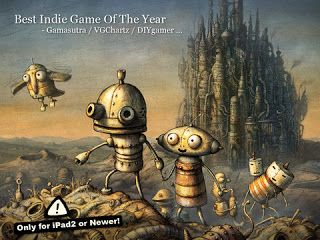 The first thing I noticed when starting up the game, was the fantastic graphics. The beautiful, amazing, mind-blowing, hand-drawn graphics are outstanding. And the way that the movable objects and computer graphics interact with the hand-drawn graphics is simply stunning. The animations are spectacular, and coupled with the music and sound effects, it all creates one incredible atmosphere, and portrays a great deal of emotion throughout the game. If you’re curious, the game is an exact port of the PC/MAC and PS 3 versions.
The first thing I noticed when starting up the game, was the fantastic graphics. The beautiful, amazing, mind-blowing, hand-drawn graphics are outstanding. And the way that the movable objects and computer graphics interact with the hand-drawn graphics is simply stunning. The animations are spectacular, and coupled with the music and sound effects, it all creates one incredible atmosphere, and portrays a great deal of emotion throughout the game. If you’re curious, the game is an exact port of the PC/MAC and PS 3 versions. 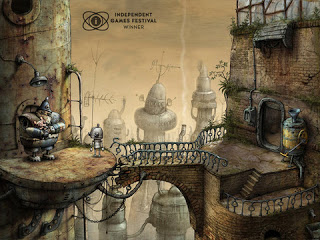 Now, I’ll quickly admit that I haven’t had the pleasure of playing many Point & Click games, but from what I have played, the puzzles that you need to complete in Machinarium are incredibly creative, and at times, can be fairly difficult to figure out, and some of them can seem downright unfair. Even with other titles within the puzzle genre, I’ve never come across this level of difficulty. However, not once did it become difficult to the point that it was frustrating. If anything, the difficulty ended up driving my addiction and love for the game every step of the way.
Now, I’ll quickly admit that I haven’t had the pleasure of playing many Point & Click games, but from what I have played, the puzzles that you need to complete in Machinarium are incredibly creative, and at times, can be fairly difficult to figure out, and some of them can seem downright unfair. Even with other titles within the puzzle genre, I’ve never come across this level of difficulty. However, not once did it become difficult to the point that it was frustrating. If anything, the difficulty ended up driving my addiction and love for the game every step of the way. 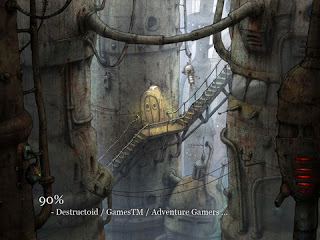 The story isn’t immediately clear when you start up the game, but as you progress, and find out that you’re not alone, and that this machine world is full of quite a few different robots and machine-beings, all with different personalities of their own, all expressed and conveyed in a way that everyone and anyone, no matter their past, cultural background, or language, can completely understand and feel comfortable with knowing what it going on with all of them. And as you progress, and get to know and help these other robots throughout the world, the story opens up, and your main objective becomes clear.
The story isn’t immediately clear when you start up the game, but as you progress, and find out that you’re not alone, and that this machine world is full of quite a few different robots and machine-beings, all with different personalities of their own, all expressed and conveyed in a way that everyone and anyone, no matter their past, cultural background, or language, can completely understand and feel comfortable with knowing what it going on with all of them. And as you progress, and get to know and help these other robots throughout the world, the story opens up, and your main objective becomes clear.
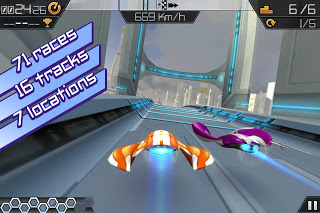 Using technology developed by another Italian company, Raylight, AXL: Full Boost stands out by including orbs into the racing. These orbs can either be used to boost your racer, reaching insane speeds, or you can use them to take advantage of power-ups found throughout the tracks. The catch is, when you use these orbs, they’re left behind you, giving your opponents the opportunity to pick them up, and use them themselves, adding an extra little layer of strategy to the gameplay.
Using technology developed by another Italian company, Raylight, AXL: Full Boost stands out by including orbs into the racing. These orbs can either be used to boost your racer, reaching insane speeds, or you can use them to take advantage of power-ups found throughout the tracks. The catch is, when you use these orbs, they’re left behind you, giving your opponents the opportunity to pick them up, and use them themselves, adding an extra little layer of strategy to the gameplay.
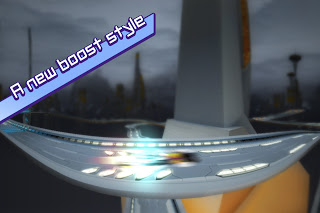 Once you get into the game, you’ll notice that not only do the graphics stand-out, but the automations are also fantastic as well, drawing you into the game even more. One of my favorite animations in the game is when you break, and get ready to boost, and your whole racer changes shape. It definitely adds to the feeling as well as style of the game.
Once you get into the game, you’ll notice that not only do the graphics stand-out, but the automations are also fantastic as well, drawing you into the game even more. One of my favorite animations in the game is when you break, and get ready to boost, and your whole racer changes shape. It definitely adds to the feeling as well as style of the game.
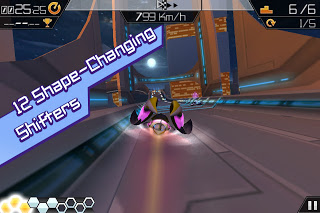 There is loads of content within the game, 3 different modes; Starcade (or Story/Carrer Mode), Free Run, and Custom Race. As you progress through Starcade Mode, more tracks, and more Shifters will become available to you, there are 12 total, each having different statistics. Starcade Mode offers up 71 different races spread across 7 different locations. Free Run lets you practice on any one of the tracks that you’ve already reached, and Custom lets you race against however many opponents you want, and lets you decide if there’s power-ups included or not, as well as which track you race on.
There is loads of content within the game, 3 different modes; Starcade (or Story/Carrer Mode), Free Run, and Custom Race. As you progress through Starcade Mode, more tracks, and more Shifters will become available to you, there are 12 total, each having different statistics. Starcade Mode offers up 71 different races spread across 7 different locations. Free Run lets you practice on any one of the tracks that you’ve already reached, and Custom lets you race against however many opponents you want, and lets you decide if there’s power-ups included or not, as well as which track you race on. 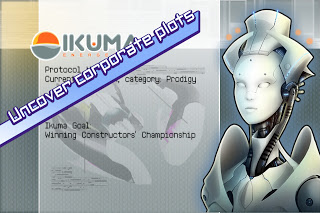 Running at a smooth 60FPS, even on my 4th GEN Touch, which, with each passing week, is becoming more and more obsolete, and has fantastic tracks, amazing graphics and animations and great music and effects, with outstanding stand-out of the crowd mechanics with the orbs, power-ups, and turns. There are also 24 achievements, and 14 leader boards included in GameCenter, which definitely adds to the replay value, which is, of course, already fairly high. Sadly, the game is not Universal, which means you’ll be playing it in 2X mode if you’ve got an iPad. AXL: Full Boost is priced at $2.99, which is a fantastic price. Fans of the genre should definitely pick this up. It stands out in a genre full of like-minded titles, offers loads of content and basically endless replay value. It could very well wind up being the best racer available for the iOS, maybe even one of the best racers available on any gaming platform.
Running at a smooth 60FPS, even on my 4th GEN Touch, which, with each passing week, is becoming more and more obsolete, and has fantastic tracks, amazing graphics and animations and great music and effects, with outstanding stand-out of the crowd mechanics with the orbs, power-ups, and turns. There are also 24 achievements, and 14 leader boards included in GameCenter, which definitely adds to the replay value, which is, of course, already fairly high. Sadly, the game is not Universal, which means you’ll be playing it in 2X mode if you’ve got an iPad. AXL: Full Boost is priced at $2.99, which is a fantastic price. Fans of the genre should definitely pick this up. It stands out in a genre full of like-minded titles, offers loads of content and basically endless replay value. It could very well wind up being the best racer available for the iOS, maybe even one of the best racers available on any gaming platform.